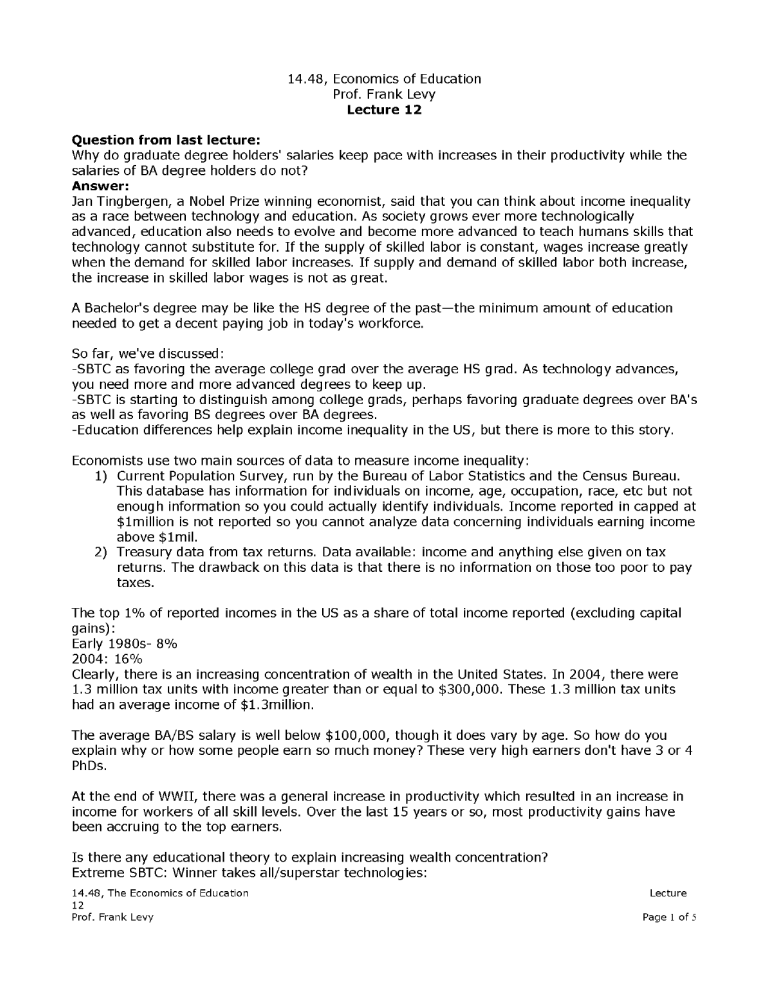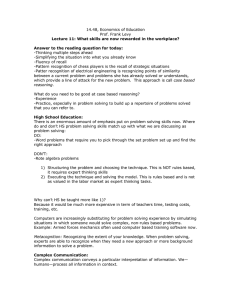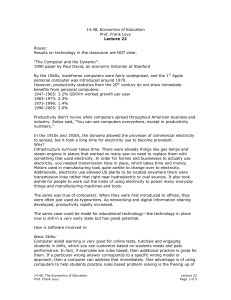14.48, Economics of Education Prof. Frank Levy 1 2

14.48, Economics of Education
Prof. Frank Levy
Lecture 1 2
Question from last lecture:
Why do graduate degree holders' salaries keep pace with increases in their productivity while the salaries of BA degree holders do not?
Answer:
I a n Tingbergen, a Nobel Prize winning economist, said that you can think about income inequality as a race between technology and education. As society grows ever more technologically advanced, education also needs t o evolve and become more advanced t o teach humans skills that technology cannot substitute for. I f the supply of skilled labor is constant, wages increase greatly when the demand for skilled labor increases. I f supply and demand of skilled labor both increase, the increase in skilled labor wages is not as great.
A Bachelor's degree may be like the HS degree of the past-the minimum amount of education needed t o get a decent paying job in today's workforce.
So far, we've discussed :
-SBTC as favoring the average college grad over the average HS grad. As technology advances, you need more and more advanced degrees t o keep up.
-SBTC is starting t o distinguish among college grads, perhaps favoring graduate degrees over BA's as well as favoring BS degrees over BA degrees.
-Education differences help explain income inequality in the US, but there is more t o this story.
Economists use two main sources of data t o measure income inequality:
1) Current Population Survey, run by the Bureau of Labor Statistics and the Census Bureau.
This database has information for individuals on income, age, occupation, race, etc but not enough information so you could actually identify individuals. Income reported in capped a t
$lmillion is not reported so you cannot analyze data concerning individuals earning income above $ l m i l .
2) Treasury data from tax returns. Data available: income and anything else given on tax returns. The drawback on this data is that there is no information on those too poor t o pay taxes.
The top 1% of reported incomes in the US as a share of total income reported (excluding capital gains):
Early 1980s- 8%
2004: 16%
Clearly, there is an increasing concentration of wealth in the United States. I n 2004, there were
1.3 million tax units with income greater than or equal t o $300,000. These 1.3 million tax units had an average income of $1.3million.
The average BA/BS salary is well below $100,000, though it does vary by age. So how do you explain why or how some people earn so much money? These very high earners don't have 3 or 4
PhDs.
At the end of WWII, there was a general increase in productivity which resulted in an increase in income for workers of all skill levels. Over the last 15 years or so, most productivity gains have been accruing t o the top earners.
I s there any educational theory t o explain increasing wealth concentration?
Extreme SBTC: Winner takes all/superstar technologies:
14.48, The Economics o f Education
12
Prof. Frank Levy
Lecture
Page 1 o f 5
-The idea is actually fairly old. Alfred Marshall, a Cambridge economist, wrote in the early 1900s about anything and everything, including super star professions.
-iPhone; I t is projected t o initially make a lot of money but competitors will eventually enter the market with close substitutes and capture some of the market.
-What about someone with a skill that does n o t have a close substitute? Say a rich businessman has a legal problem. Lawyer Smith is said t o be the best litigator in all of London. Therefore, he can charge very high fees because there is no direct competition.
I n the 1980s, there were enormous rounds of takeovers, and investment bankers could charge very high fees because companies thought they needed their expertise for a deal that could only be done once. watch a golf tournament, you had to wait for one of the many PGA tournaments t o play nearby.
Now, you can just turn on your TV and watch a famous tournament. However, most people know and watch for the famous like Tiger Woods.
Why were productivity gains shared more equitably in the past?
There were a lot of other factors involved other than just increasing productivity, especially government involvement through high taxes as well as unions pushing for higher wages.
Where did the legislation come from in the past?
The New Deal policies were implemented in part t o prevent another depression and also t o life the economy out of the Great Depression. I n 1933, the economy was miserable. Unemployment was around 25%, and the country was plagued by labor unrest. What would you do in response? There wasn't any macroeconomic policy for the government t o follow. One idea was that transactions in the economy weren't generating enough money t o get the economy moving. I f prices and wages were kept high, transactions will generate significant income for people.
How would you analyze this approach today? This policy isn't going t o employ more people with high transaction costs. I t will result in fewer transactions, with each individual transaction worth more.
So what really got the US out of the Great Depression? WWII, which required huge levels of deficit spending.
Truman's 1945 conference: President Truman held an economic conference on labor relations which lasted 3 weeks. He invited 34 people including business leaders, heads of unions, etc. Many people in the government and industry were worried that unions were going t o make huge demands for increases in wages, benefits, etc post WWII which could escalate into strikes across the country. Truman called together all the people he thought he needed t o control wages, prices, and union behavior.
Why was this system/approach abandoned? See Inequality a n d Institutions in 20th Century
America by Levy and Temin.
Goals of Education:
1) Stronger basic skills
2) More advanced skills
3) More kids t o college
Tools for K-12 Education:
1) More money or smaller class sizes
2) School choice
14.48, The Economics o f Education
12
Prof. Frank Levy
Lecture
Page 2 o f 5
3) Standards and assessments
4) I n service teacher training, better teacher selection
5) Technology in the classroom
Education Production Functions:
(Achievement Test score),
= a,+ Z ( x v )
Ok, but what do we mean by a production function?
Cobb-Doug lass:
Q
=
~ ' " - 1 '
What are we assuming when we use these functions?
There are a lot of different ways t o produce a given output level, in this case a test score. When we look a t a firm's inputs and outputs, we observe their labor and capital choices and the quantity of the resulting output. Firms t r y t o achieve an efficient combination of labor and capital t o maximize profits, but it is certainly possible t o choose a non-optimal combination of K,L.
Analogously, when we t r y t o estimate an education production function, we assume the only thing that teachers and students t r y t o do in the classroom is maximize test scores. But we know that this is not true.
What else might schools want t o do?
-Make sure student graduate or minimize dropouts, which won't maximize achievement and test scores because you will lower standards by, perhaps, creating easier courses
-Extracurricular activities
-Get students into college
-Social programs such as DARE
-Vocational training: These skills not likely t o show up in achievement test scores at all
Does the amount of money schools given matter? Or does the amount of money schools are given not mater because of the way they spend it now?
I n the United States, there are 13,000 independent school district, but they are not actually fully independent. Funding for a school, on average, is comprised of:
&O/O
Federal funding, 45% state funding, and 48% local funding. However, these numbers do vary quite a bit from state t o state.
I n California: The state government provides much more money than the local governments.
Why? Proposition 13 basically froze property tax levels, severely restricting local funds.
State funding typically comes in two forms.
1-Base aid, which is the same for all schools in the state
2- Equalization ad, which puts more money into schools in poorer school districts
What exactly is independent about these school districts? They do their own hiring but states are controlling ever more of the curriculum.
ACT analyzed test scores in 2005:
26% of students taking the ACT were ready for a college intro Biology course
40% were ready for a college intro Algebra course
68% were ready for a college intro English course
14.48, The Economics o f Education
12
Prof. Frank Levy
Lecture
Page 3 o f 5
I n other words, schools are not doing a very good job of preparing students for college and more remedial work must be done in college and junior college.
The National Assessment of Educational Progress, run by the Department of Education, has collected the following data:
Note: A math score of 300 is equivalent t o performing moderately complex reasoning for the specified age group
The percentage of students receiving a Math score exceeding 300:
Age 13:
1970: 65%
1990: 75%
2004: 63%
Age 17:
1970: 52%
1990: 56%
2004: 59%
Progress for older students has been slower. This has a lot t o do with the classes that students do not take rather than the effectiveness of classes they do take.
What about classroom distractions like text messaging? This may be an issue. Would need further study,
Note: An English language score of 300 is equivalent t o understanding complicated information for your age group.
The percentage of students receiving an English language score exceeding 300:
Age 13: Age 17:
1971: 58%
1990: 59%
2004: 61%
1971: 39%
1990: 41%
2004: 38%
What appears t o be a lack of progress in English language teaching in the data above may actually be a result of an influx of students in the US public school systems that do not speak
English as a first language,
What do parents think about schooling in the US?
A survey asked parents: what grade would you give public schools in the nation? Your community? The school that your oldest child attends?
% giving A or B grade
Nation Your Community
All Persons
Parents
1995
20%
18%
2006
24%
22%
1995
41%
49%
2006
49%
61%
School Oldest Child
Attends
1995
.
.
2006
.
.
65% 64%
On the national level, there is a perception of of poor quality while people think there local schools perform decently and their own child's school a bit better than the average local school.
What is going on here? College preparation is not that good across the US, but parents think their children are just fine. How do you square this?
Well, how would a parent actually know if a child's school were bad? Parents can really only find
14.48. The Economics o f Education
12
Prof. Frank Levy
Lecture
Page 4 o f 5
out many years later whether a child's school has done a good job in teaching them complex communication, expert thinking, etc. Additionally, if a parent thought her child's school was really quite bad, she'd pull her child out and find another school.
14.48, The Economics o f Education
12
Prof. Frank Levy
Lecture
Page 5 o f 5




